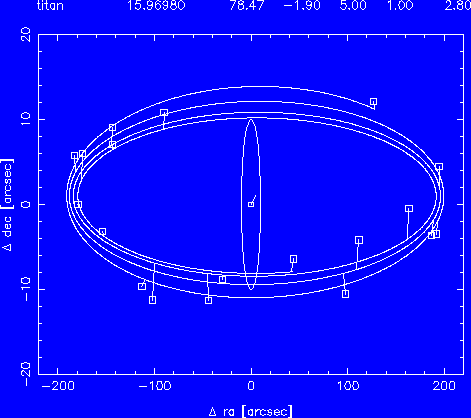 |
Department of Physics | AstroLab |
Moons of Saturn
Saturn is the second largest planet in the solar system. It has a large number of satellites. The largest is Titan which is about 50% bigger than the Moon. Titan orbits Saturn in a period of about 16 days. Other large satellites include Tethys, Dione and Rhea. These orbit Saturn with periods ranging from 2 to 5 days.
The goal of the project is to obtain
a series of images of Saturn and its satellites so that the orbital periods
of as many of the satellites as possible can be determined. How well can
these periods be determined from the data obtained? What is the evidence
for orbital resonances? Software is available to aid the identification of
the satellites. This project would benefit from a student group willing to
make more observations (at least 15).
An example of the type of observations and analysis required is given below.
|
|||
| This image is a 0.3 second exposure of Saturn taken with the ST7 CCD on the 10-inch telescope on 2003-Mar-14 at 19:02. The inset image in the lower right hand corner is a 2x zoomed subimage of Saturn. |
By taking a series of such images the relative position of the moons can be readily determined. The diagram below shows the results of models used to estimate the orbital period of Titan. The x- and y-axes shows offsets of Titan from Saturn at various dates during the 1996 Michalmas term. The y-axis has been expanded to illustrate Titan's elliptical orbit. The observations are shown as squares. The elliptical curve is a model with a sidereal orbital period of 15.9698 days.
 |
Using such observations and analysis, 3rd year students Jane Barlow and Geoff Hodbod derived the following results:
Satellite |
Measured |
Almanac |
Titan |
15.9563 +/- 0.015 |
15.945421 |
Rhea |
4.518 +/- 0.027 |
4.517500 |
Dione |
2.737 +/- 0.019 |
2.736915 |
Tethys |
1.886 +/- 0.014 |
1.887802 |
Iapetus |
76.9 +/- 0.6 |
79.330183 |
An alternative approach to derive the orbital periods was used by Lisa Mitchinson and Alex Marshall in the Epiphany term 2000 where they considered the variation of the distance of each moon from Saturn. The graph below shows their results for Titan. The squares show the measured distance of Titan from Saturn on various days in the term. The curve shows their best fit model which has a period of 15.9456 +/- 0.0020 days.
 |
Project Notes Project References
| Back to the AstroLab Home Page | jrl | 2013-Dec-22 23:30:43 UTC |
